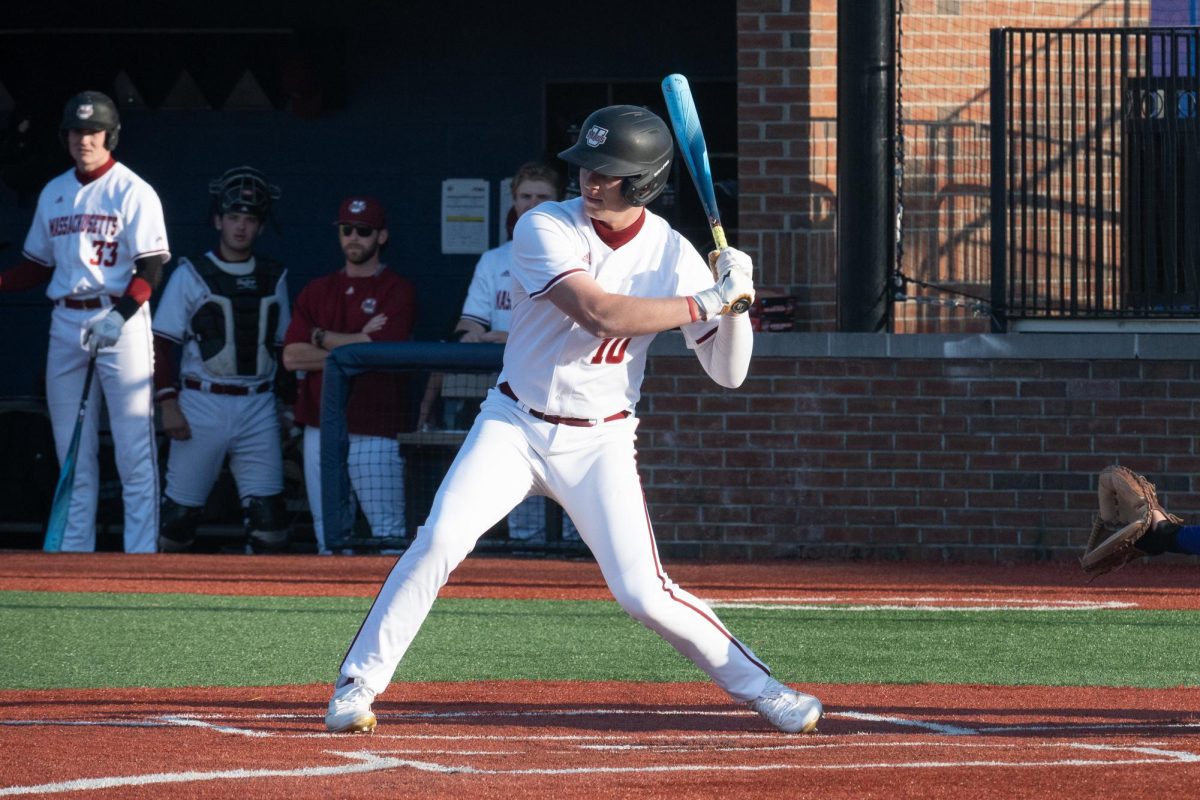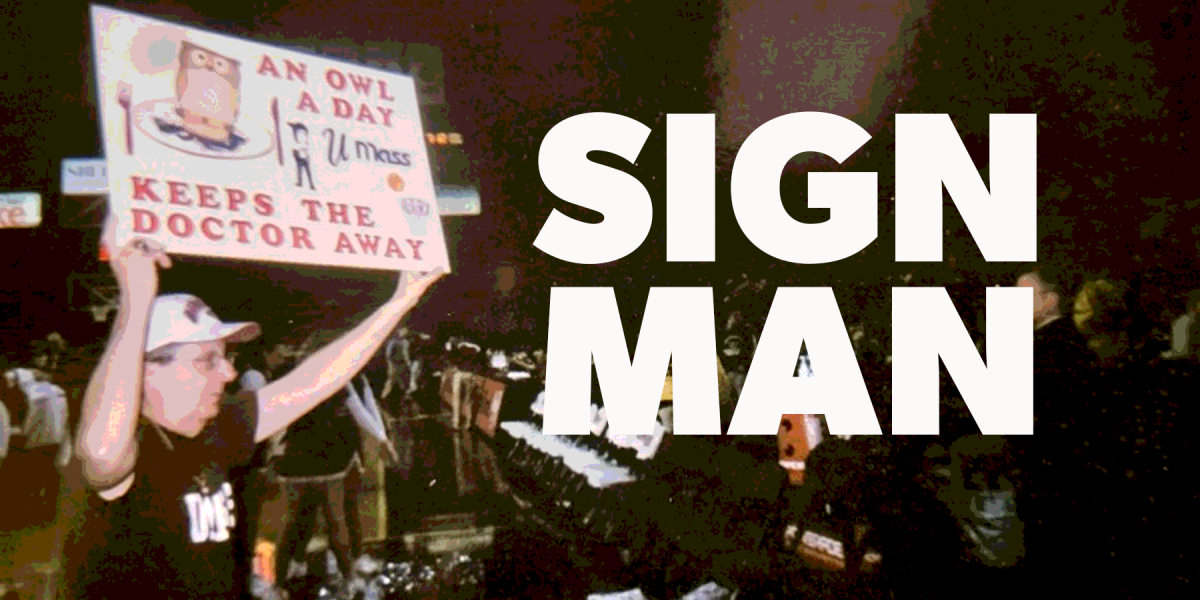Chancellor David K. Scott laid out his 10-year Investment Plan before a sparse audience yesterday just after 8:30am in the Campus Center Auditorium while members from the Student Coalition Against Racist and Classist Education (SCARCE) silently lined the wall in protest of low numbers amongst students of color and low income at the University of Massachusetts.
In a recent news release, SCARCE wrote, “This meeting [was] held purposely at 8:30 in the morning in the hopes that students [would] not attend.” Twenty-two representatives from SCARCE came to the demonstration.
In his welcoming speech, Scott commented that the future investment plan he would explain over the course of the next hour and a half had been submitted to and rejected by the President of UMass, William Bulger.
“That’s good,” he said. “Now, you have a chance to reshape it,” adding that the new chancellor would be able to look at this plan and build from it.
Covering a wide range of topics, Scott addressed recent concerns on student/instructor ratios, diversity amongst students and faculty, intercollegiate athletics, and the distribution of university funds.
He explained that the ratio of total students to total instructors has remained roughly constant for 10 years at 15/1 because the number of non-tenure system faculty and professional staff has increased at a similar rate of decrease among the numbers of full-time faculty.
“The ratio had remain the same, but the mix has changed, but I believe the ratio will decrease,” he noted. “If we do it [plan a decrease in full-time faculty] by design and not by default, it will work.”
About half an hour into Scott’s address, the SCARCE members, dressed in black clothing to show “solidarity with those who have disappeared or cannot come to UMass,” began to make their way to the front of the auditorium.
With black taped covering their mouths, the members carried the “gravestones” of those who had to leave the university as a result of their race or class.
For about ten minutes, the line faced the audience as Scott continued to speak on the elevated stage just behind them before propping their signs against the front of the stage and making their way out of the room.
Soon after, Scott acknowledged that there is a definite under representation of African American students at UMass, also noting that now that he was talking about their [SCARCE] issue, they had left. Some SCARCE members who had retreated to sit among the rest of the audience to listen to Scott’s speech reassured him that they were still present.
“[We must] maintain the commitment to reflecting diversity of four-year college-bound graduation seniors from high schools in Massachusetts,” read Scott from his laptop computer.
He presented statistics that in 1999, 18.4 percent of all Massachusetts high school students were of African, Latino, Asian, and Native American (ALANA) ethnicity, yet only 13.4 percent of Massachusetts high school students who had taken college prep were ALANA.
Concluding that UMass Amherst was well within those statistics since 16.7 percent of the entering class of 2000 was ALANA students, Scott acknowledged that the university uses an affirmative action policy to an extent as far as is legally permitted by the state.
“We also exceed [the state’s high school statistics] in percentages of Hispanic, Asian, and Native American students,” he stated. “But we’re lacking in percentages of African Americans.”
After expressing his doubts in SATs scores as good indicators for college students, he explained about a systemic outreach program with K-12 that would ensure that high school graduation rates would become more representative of the potential amongst all students.
“Take advantage of retirements of faculty and staff over 10 years to build a new level of diversity into all parts of the university,” read a statement from his plan, showing that he did not want to limit diversity issues to students alone.
Moving on to intercollegiate athletics, Scott said he wanted to develop an athletics review committee to determine the appropriate range of sports and levels of competition at UMass.
“A move to Division I-A football could bring the University to a new level of competition, athletically and academically,” he said, adding that a risky 10-year business plan to reduce financial backing has been developed.
However, he cautioned that such a move should only be undertaken in the context of the special investment by the Commonwealth to create the Integrative University of the 21st century.
“To do it without such a move is madness,” he remarked. “Failure to move in this direction could mean the elimination of an array sports or the elimination of I-AA football.
Following his speech, Scott added that the largest emphasis is put on the basketball and football teams. But, rather than the elimination 12 other sports, it would make more sense to eliminate football “but I don’t want it to happen,” he said.
Scott also presented three possible scenarios for distribution of the university funds. Scenario I described a situation in which state appropriation growth equaled 4.5 percent, while in Scenarios II and III, state appropriation growth equaled 3.5 percent.
In scenarios I and II, the Distance Learning program was given 8.6 million dollars, financial aid 8.3 million, athletics 1.6 million whereas salaries were given 102.0 million under scenario I and 82.0 million under scenario II. Scenario III was left open for a later discussion. Scott also reminded the audience that scenarios are not reality.
“This is not the only solution. It’s only a discussion, but we can’t fail to have the discussion at all,” he told the audience. “No one has to change. Everyone has to have the discussion.”
He also mentioned that he would be in favor of unfreezing university student tuition prices and raising them and also mentioned the fate of certain offices on the campus community.
According to Scott, the Everywoman’s Center, the Residential Education Assistant Program, the Office of Equal Opportunity, and the Diversity Jewish Awareness and Anti-Semitism program, among many others, are the programs to be cut first.
“These are actually the last things you should take out,” he stated proposing that it would be better to combine them rather than delete them altogether.
As 10:30 a.m. approached, Scott concluded his Strategic Intent for the future of UMass by expressing his wishes for his successor, remarking, “The next chancellor needs to be much more external-oriented than I was.”
Upon asking for any questions or comments, Scott was greeted by sophomore Johnette Ellis, an Afro-American major, who approached the floor microphone and asked him to revisit his previous comment on UMass “doing away with” the idea of a land grant institution in order to approach the concept of an integrative university.
Scott responded, “I wanted to free the thinking to get people to talk about the connection between a land grant and research institution.”
Claiming to believe in everything a land grant university would represent, he regrettably said that ideas within land grant and research institutions are pitted against each other. The concept of a land grant was made in 1862 with a Morrill Act, and Scott said he believes in moving on to incorporate newer ideas as well as the old.
Jessica Fink, graduating senior and a BDIC major, said to Scott, “I want to know why, without any fancy talk, there no students of color on this campus. Why do we have different statistics than you?”
Recalling a recent study he had read, Scott said that most people do not notice a certain group until that group exceeds 30 percent, and thus walking around on the campus may make one feel like there are less students of color here than there actually are.
“How far and how fast should we go to eliminate white students to make room for students of color?” he began to
question when a man from the audience asked why the University could not just increase the number of students on campus and bring in more students of color without taking in less white. Scott did not approve of this idea.
Before he had to leave for another meeting, Scott was addressed on one last point.
“By raising tuition prices,” Fink said. “We’re never going to bring in more lower class white students and people of color [to this campus].”
However, he was unable to get into a long discussion on the topic due to his other engagement. Finally, he was invited to attend a SCARCE meeting by one of their members.
While some SCARCE students felt hope when Scott remarked, “Students aren’t always right, but they have an idea worth looking at,” during his presentation, many of them felt unsatisfied with only receiving about fifteen minutes to speak with him.






